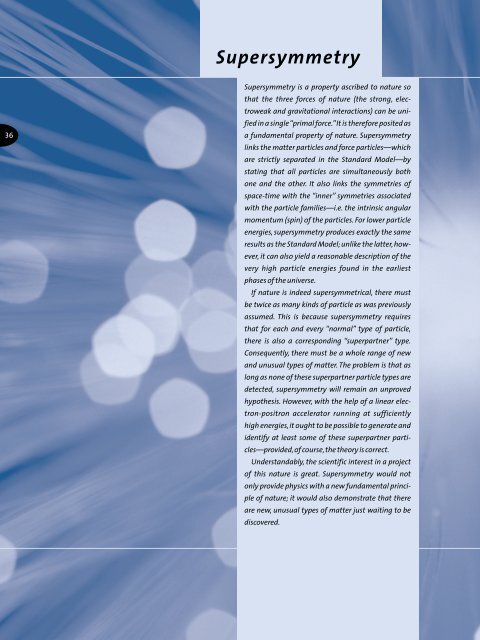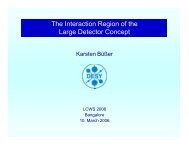TESLA Brochure - ACFA Joint Linear Collider Physics and Detector ...
TESLA Brochure - ACFA Joint Linear Collider Physics and Detector ...
TESLA Brochure - ACFA Joint Linear Collider Physics and Detector ...
You also want an ePaper? Increase the reach of your titles
YUMPU automatically turns print PDFs into web optimized ePapers that Google loves.
36<br />
Supersymmetry<br />
Supersymmetry is a property ascribed to nature so<br />
that the three forces of nature (the strong, electroweak<br />
<strong>and</strong> gravitational interactions) can be unified<br />
in a single “primal force.”It is therefore posited as<br />
a fundamental property of nature. Supersymmetry<br />
links the matter particles <strong>and</strong> force particles—which<br />
are strictly separated in the St<strong>and</strong>ard Model—by<br />
stating that all particles are simultaneously both<br />
one <strong>and</strong> the other. It also links the symmetries of<br />
space-time with the “inner” symmetries associated<br />
with the particle families—i.e. the intrinsic angular<br />
momentum (spin) of the particles. For lower particle<br />
energies, supersymmetry produces exactly the same<br />
results as the St<strong>and</strong>ard Model; unlike the latter,however,<br />
it can also yield a reasonable description of the<br />
very high particle energies found in the earliest<br />
phases of the universe.<br />
If nature is indeed supersymmetrical, there must<br />
be twice as many kinds of particle as was previously<br />
assumed. This is because supersymmetry requires<br />
that for each <strong>and</strong> every “normal” type of particle,<br />
there is also a corresponding “superpartner” type.<br />
Consequently, there must be a whole range of new<br />
<strong>and</strong> unusual types of matter. The problem is that as<br />
long as none of these superpartner particle types are<br />
detected, supersymmetry will remain an unproved<br />
hypothesis. However, with the help of a linear electron-positron<br />
accelerator running at sufficiently<br />
high energies,it ought to be possible to generate <strong>and</strong><br />
identify at least some of these superpartner particles—provided,of<br />
course,the theory is correct.<br />
Underst<strong>and</strong>ably, the scientific interest in a project<br />
of this nature is great. Supersymmetry would not<br />
only provide physics with a new fundamental principle<br />
of nature; it would also demonstrate that there<br />
are new, unusual types of matter just waiting to be<br />
discovered.




